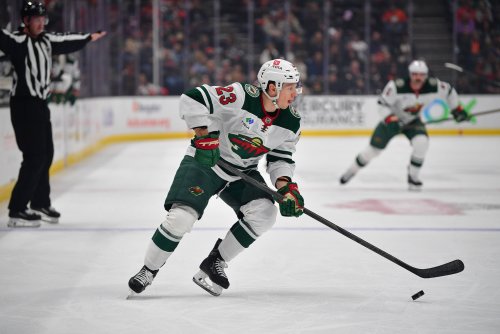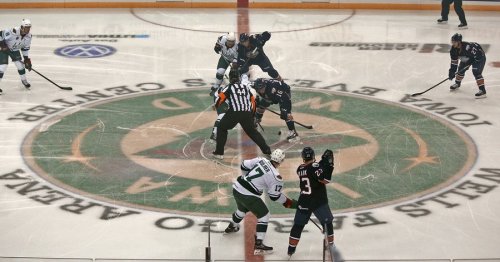
Back on July 1, the first day of NHL free agency, the Minnesota Wild signed veteran winger Mats Zuccarello to a five-year deal worth $6 million annually. Zuccarello’s deal includes a full no-move clause and a modified no-trade clause in the final two years of his contract — a bit strange considering the long-time New York Rangers star will turn 32 in just a couple weeks.
But, you know, Paul Fenton and all.
Less than ideal contract notwithstanding, it’s hard not to be at least a little excited about the addition of Zuccarello. In his nine-year NHL career, he has collected 114 goals and 355 points in 511 regular-season games between the Rangers and Dallas Stars (though he only played in two regular-season contests as a member of the Stars this past season). He has reached the 50-point mark four times in his career and, back in 2014-15, fell just one point shy of that milestone.
Zuccarello may be on the wrong side of 30, but he still figures to be a versatile addition to Minnesota’s top six. Not just because he’s a proven scorer, but because he remains an excellent skater, plays with some admirable physicality despite being rather small in stature and regularly sacrifices his body to block shots — in 2017-18, he ranked fifth on the Rangers (and led all New York forwards) with 67. But don’t just take my word for it. Paul Fenton himself was about as giddy as anyone could possibly be at the time of Zuccarello’s signing.
“I told him when I was talking to him that he’s like a lizard, the way a lizard takes his tongue and sticks it as far as it does and retrieves what it was trying to do,” Fenton said. “When you look at Mats, he’s not the tallest in stature, but he uses an incredibly long stick and he reaches into piles, comes out with things, and most of the time, guys would be awkward with a stick that is as long as he uses, but he’s so natural, fluid, smooth, he comes out with things and he’s able to make plays.”
Man. What a quote.
Though Fenton didn’t exactly do a great job of properly verbalizing what Zuccarello can bring to the Wild, it’s no secret that the Norwegian forward is an incredibly useful player — particularly when it comes to creating offense.
Last season, Zuccarello averaged close to a point per game with 12 goals and 28 assists in 48 games while spending most of the year on a bad Rangers team. While his 5-on-5 Corsi For percentage was nothing to write home about (48.62), his 3.71 Corsi For percentage relative to his teammates at even strength ranked fourth-best on the Rangers (not counting defenseman Libor Hajek, who only appeared in five NHL games in 2018-19).
As good as Zuccarello is at generating offense, he tends to be at his best when manufacturing high-danger scoring chances around the low slot. In fact, he led all Rangers forwards not named Kevin Hayes last season with a 53.85 HDCF% at 5-on-5 before being traded to the Stars. The graphic below, courtesy of Micah Blake McCurdy of HockeyViz, does a pretty good job of showcasing Zuccarello’s impact in this area of the ice.
Zuccarello didn’t slow down once he arrived in Dallas, either. In his very first game as a Star, he registered a goal and an assist, helping to lift the Stars over the Chicago Blackhawks for a 4-3 road victory. Unfortunately, he suffered a broken arm after blocking a shot that evening as well, which knocked him out of action until the Stars’ third-to-last game of the regular season. In the playoffs, even despite coming off a significant injury, he didn’t skip a beat. Though his “fancy stats” weren’t anything special (45.83 CF%, 44.97 xGF% at 5-on-5), Zuccarello tied with Stars center Tyler Seguin for the team lead in points with 11 in 13 postseason contests.
There are a number of factors that make Zuccarello so effective offensively. But perhaps the most obvious is his ability to distribute the puck. A good example of his exceptional passing is this power-play assist against the New Jersey Devils. After receiving a pass from his point man, Zuccarello surveys the ice and threads the needle between two New Jersey defenders in the slot area to an uncovered Mika Zibanejad, who beats goaltender Keith Kinkaid for the game-tying score.
Let’s take a look at another example. In the clip below, Zuccarello pulls off one of the more impressive plays of his career. While being pursued by a pair of Carolina Hurricanes defenders, Rangers forward Chris Kreider chips the puck in deep to Zuccarello, who is stationed along the end boards. Zuccarello then delivers a gorgeous between-the-legs feed to Zibanejad for an easy score to tie the game. Carolina’s goaltender had almost no time to prepare for Zibanejad’s shot, and by the time he realized what happened, the puck was already across the goal line.
Another one of Zuccarello’s more admirable traits is his patience with the puck on his stick. The clip below is a bit outdated — it’s from all the way back in December of 2017 — but it still exhibits just how lethal Zuccarello can be when given time and space in the attacking zone. Especially on the power play (his 14 power-play points finished second on the Rangers last season despite only playing in 46 games).
After showing off his passing in the clips above, this one not only shows off Zuccarello’s patience, but his impressive shot as well. In the midst of a 4-on-3 power play in overtime against the Boston Bruins, Zuccarello scans the ice for options as Patrice Bergeron, Zdeno Chara and Brandon Carlo all helplessly await his next move. Rather than making an ill-advised pass to a covered forward or delivering the puck back to his point man, Zuccarello eventually takes the alternative route and snipes one past Jaroslav Halak to win the game for New York.
A more recent example of his equanimity comes from Game 1 in Dallas’ second-round series against the St. Louis Blues. Zuccarello enters the St. Louis zone and, rather than attempting to create a play on his own, he delays back and drops off a pass for Stars defenseman John Klingberg, who eventually hits Jason Spezza with a cross-ice feed to tie the game. Though Zuccarello “only” picked up a secondary assist on this play, it still serves as a good example of what makes Zuccarello an effective puck distributor.
When it comes to offense, Zuccarello seems to check pretty much all of the boxes. But what about when the puck isn’t on his stick?
Well, he’s still pretty good.
Zuccarello finished 2018-19 with 38 takeaways, which would have ranked tied for the fifth-most on the Rangers. Again, pretty impressive considering he missed roughly half of the season due to injury. In 2017-18, though, he lead the entire Rangers roster with 69 very nice takeaways on the season while leading all New York forwards by a country mile with nearly 1,514 minutes of ice time.
The Rangers’ coaching staff trusted Zuccarello immensely during his time in New York, and it’s not hard to see why — especially when he makes plays like this one.
Here’s another look at some of Zuccarello’s defensive work. And this example comes against the team he eventually wound up being traded to this past February. With Stars sniper Alexander Radulov stationed in the low slot awaiting a feed from Mattias Janmark, Zuccerallo shows up just in the nick of time, knocking the puck away from the two-time 70-point getter before he can even attempt to get a shot off. Not exactly a play worthy of being shown on highlight reels, but still a sequence that can make a significant impact on a game.
All in all, Zuccarello is an extremely useful top-six forward capable of scoring around 50 points per season and playing significant minutes at 5-on-5 and on the power play. He may even spend some time killing penalties — Rangers head coach David Quinn used Zuccarello regularly in shorthanded situations as New York continued its rebuild last season.
But how much longer can we expect such production out of Zuccarello?
As good as he is right now, he, along with every player in the NHL above the age of 30, is due for a regression at some point relatively soon. It may not happen this coming season or even in 2020-2021, but it’s unlikely that Zuccarello will remain the player he currently is through the duration of his five-year contract. Add in the fact that the Wild will be forced to protect him in the upcoming expansion draft due to his no-move clause and it becomes apparent that Minnesota could have a real issue on its hands at some point down the road.
For now, however, Zuccarello is a dynamic player who can add a lot to a Wild team still hoping to contend for a playoff spot. Whether or not he’ll remain that player for much longer, though, is the $30 million question.
All statistics courtesy of Natural Stat Trick.
Think you could write a story like this? Hockey Wilderness wants you to develop your voice, find an audience, and we'll pay you to do it. Just fill out this form.









Recommended Comments
There are no comments to display.
Join the conversation
You can post now and register later. If you have an account, sign in now to post with your account.
Note: Your post will require moderator approval before it will be visible.